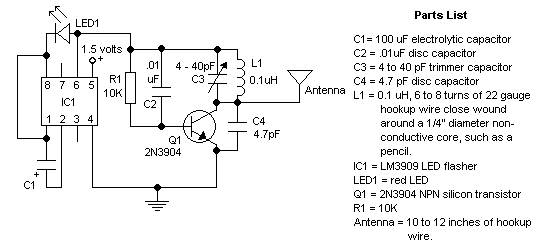ElectroMaster
Administrator
The current draw for this tracker is 3.7mA, so the 1.5V button cell will last awhile. What the heck am I suppose to hear you ask? When your circuit is working you should see the LED flash quite fast. Take your FM radio and search for the low-beat 'humbe-humbe-humbe-etc' equal to the flash of the LED (probably around the 100Mhz). Found it? If that position is interferering with a radio station you can fine-tune it with the variable capacitor. If you like to have the tracker around the 88Mhz you can do that by spreading the windings from the home-made coil just a bit (1/2 a millimeter or so). Anyways, play with it and learn. It is a nice project. The 12-inch antenna can be anything, it is not really that critical. I used a piece of 22 gauge flexible wire. I haven't checked the range but will do that shortly.

- For stability, use a NPO types for C2 & C4.
- Resistance tolerance for R1 should be 1 or 2%.
- Frequency range is the usual 87-109Mhz on the FM dial.
- The coil is made from 22 ga 'hookup' wire, like the solid Bell phone wire. Leave the insulation on.
- The LED is the 'High Brightness' type for maximum illumination.

